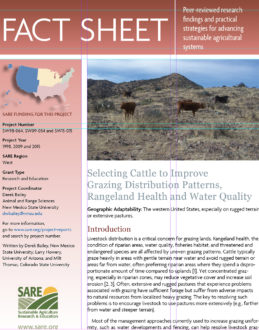The objectives of the second and third SARE projects (SW09-054 and SW15-015) were to identify and validate genetic markers that were associated with terrain use in beef cows grazing mountainous and extensive rangeland pastures. Genetic markers that are associated with phenotypic traits are often referred to as quantitative trait loci (QTL). The presence of QTL for terrain use would indicate that grazing distribution is inherited and that genetic selection could be effective.
Methodology

Cattle were tracked at 14 ranches located in New Mexico, Arizona, Colorado, Nevada and Wyoming. At each ranch, 8–35 cows were tracked with global positioning system (GPS) collars at 10- or 15-minute intervals for periods of 3–19 weeks. Cow breeds varied across ranches, but the majority were Angus or Angus crosses. Cows were tracked during the summer, fall, winter and spring seasons. At some ranches, cows were lactating and had calves, and at other ranches cows were dry. Blood samples were obtained for all tracked cows to use for DNA analyses. Most of the cows (89%) were genotyped using the Illumina BovineHD SNP array, which evaluates approximately 770,000 genetic markers (i.e., single nucleotide polymorphisms, or SNP) across the 30 bovine chromosomes. The remaining cows were genotyped using the BovineSNP50 BeadChip (53,714 SNP). In total, 330 cows were tracked, genotyped and used in the analyses.
In our earlier study (SW09-054), genetic markers associated with terrain use were identified with single SNP regression [15], which may result in more false positives than the BayesC methodology. The BayesC methodology was not available at the time of our previous study. In our latest study (SW15-05), a genome-wide association study was conducted using the BayesC methodology, which is the software now used by most breed associations for genetic evaluation. Our latest genome-wide associate study also had over 3.5 times more cows than the previous study [15].
The statistical model accounted for the ranch, season, lactation status, breed and terrain type by using the start of tracking to identify contemporary groups. Analyses were designed to identify individual genetic markers known as SNP that were associated with terrain use phenotypic traits. Important SNP were identified for each phenotypic terrain use trait and were termed as QTL or candidate SNP. Even though important SNP were identified, it was obvious that grazing distribution traits are affected by many regions of the chromosome, so we determined these are polygenic traits. This means that for future studies we need to conduct whole-genome methodologies for genetic improvement strategies, similar to most of the traits that currently have genome-assisted expected progeny difference (EPD).
Summary and Application
In the second study [15], five genetic markers (SNP) accounted for 36% of the variation in a terrain use index of slope and elevation use (Figure 2). In the last (third) study, a total of 29 putative candidate genes were identified for terrain use in beef cattle. The association of genetic markers with the use of steep slopes, high elevation and areas far from water shows that terrain use can be inherited. The large number of candidate genes demonstrates the polygenic nature of terrain use traits. The functional annotation analysis showed that these candidate genes were related to a variety of biological processes including hypoxia, feed efficiency and weight gain.
Even though important SNP were identified, it was obvious that grazing distribution traits are affected by many regions of the chromosome (i.e., they are polygenic traits). This means that for future studies we will need to conduct whole-genome methodologies for genetic improvement strategies, similar to most of the traits that currently have genome-assisted EPD.
Although these findings are exciting, the association of the genetic markers and terrain use in these studies was not yet sufficient to develop a commercially viable genomic breeding value for terrain use. However, our results demonstrate the potential to develop a breeding value that ranchers could use to rank bulls and replacement heifers for their potential to produce daughters that are willing to use rugged terrain and travel further from water. Detection of genotype to phenotype associations in the latest study was likely limited by the moderate sample size and heterogeneity in some of our data points, which is inherent in large-scale field studies. Terrain, vegetation, breeds and management varied across the 14 ranches used in the study. Therefore, a large independent population of beef cows, composed of one breed, grazing on the same pastures is needed to refine terrain-use measurements and further elucidate the role of genetics in cattle grazing distribution on rugged rangeland.
With additional research and development, ranchers may be able to identify bulls and replacement heifers that have desirable breeding values for terrain use using only DNA samples from hair or blood. In addition, the cost of GPS tracking is dropping due to technological advancements. Currently, ranchers may be able to identify cows that use steeper terrain and areas far from water using GPS tracking and visual observations. Although more research is needed, selecting for such “hill climbing” cows may improve use of rugged rangeland and may reduce grazing impacts on riparian areas.
